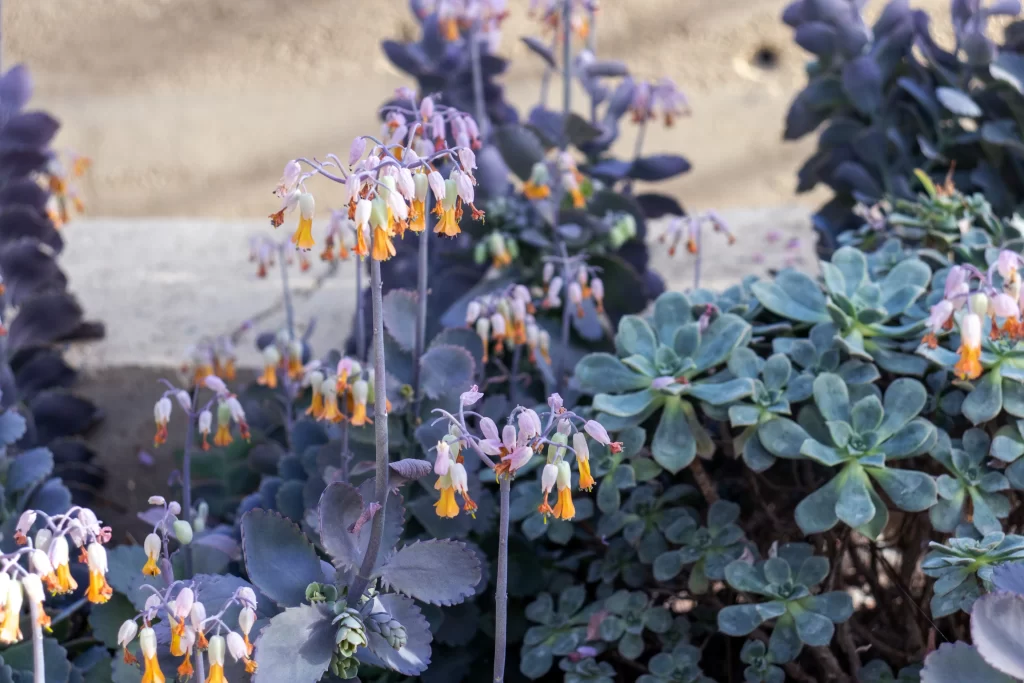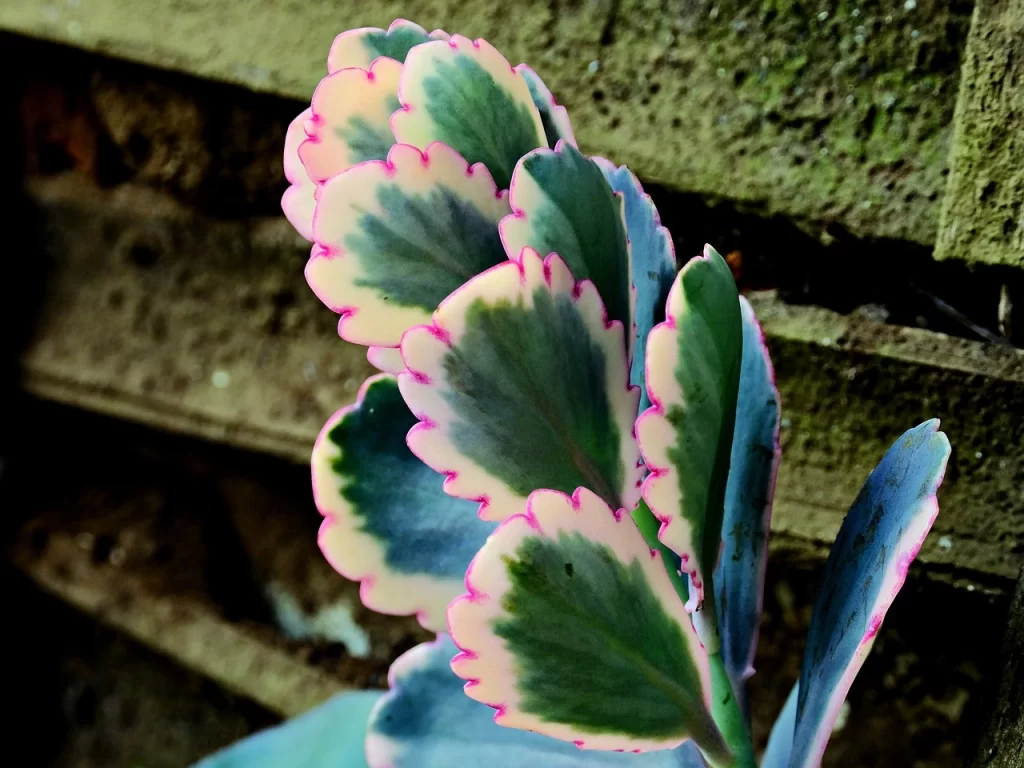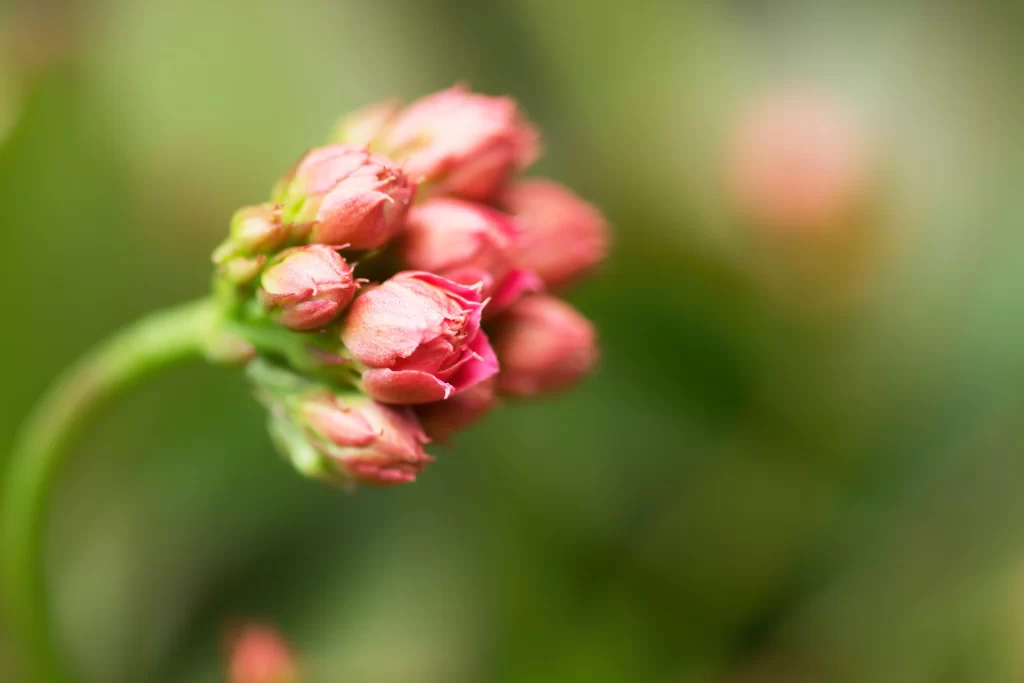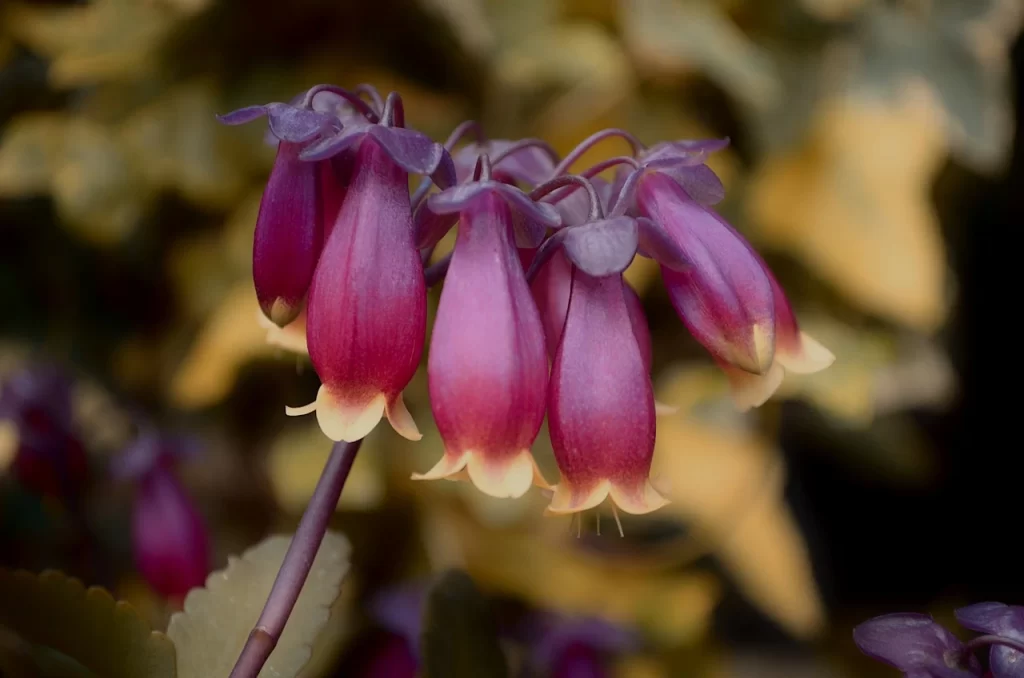Kalanchoe species are plants characterized by their erect, shrub-like growth and thick, succulent green foliage. These perennial plants boast clusters of tiny flowers with vibrant colors such as red, yellow, pink, orange, and white being common. A significant advantage is their ability to be forced into bloom at any time of the year, and their flower clusters can endure for weeks to months. Propagation is straightforward, as most species root from the leaf or offsets approach.
Read: Kalanchoe Blossfeldiana – Propagation, Care, and Toxicity

Kalanchoe fedtschenkoi Plant Characteristics
The Kalanchoe fedtschenkoi (pronounced as kuh-LANK-oh-ee fedt-SHEN-koy) is commonly known as the “Lavender Scallops” or “Mother of Thousands.” It is a succulent plant native to Madagascar[1]Basic Botanical Information Kalanchoe Fedtschenkoi. Read. Here’s a botanical overview of its characteristics:
| Kalanchoe fedtschenkoi Plant Characteristics | Description |
| Type | Small shrubby succulent having fleshy, water-storing tissues. |
| Origin | The plant’s native region is Madagascar |
| Flower Color and Blooming | Red Brown and The plant produces flowers in Spring/Summer |
| Habitat | Spreading stems root along the ground, forming large colonies. |
| Size | 1-2 feet tall |
| Variegated Foliage | The plant has thick and fleshy leaves with more than one color. This plant has scalloped leaves that mix lavender, gray-green, and cream-colored hue along the leaf edges. |
| Spread | 1-2 feet Horizontal plant spread |
| Winter Hardiness | The plant’s ability to withstand cold temperatures ranges from 25-30 °F. |
Kalanchoe fedtschenkoi Leaf Idendification
Kalanchoe is a perennial succulent in the Crassulaceae family, known for its ability to thrive in arid conditions. Succulents have thick, fleshy parts, especially in their leaves, allowing them to store water. However, they come in various shapes and sizes, with generally entire margins, but some may be crenate, serrate, or dentate. All species share the common trait of fleshy leaves, and some may have hairy leaves. Additionally, certain species, like K. daigremontiana, produce viviparous plantlets on leaf edges, aiding in vegetative propagation and plant spread.
Kalanchoe fedtschenkoi is a popular succulent with attractive purple-edged leaves. However, the leaves of Kalanchoe fedtschenkoi typically have a crenate margin. The “crenate” refers to leaves with a rounded or scalloped edge, with small, rounded teeth along the margin. These crenations create a distinctive and attractive pattern along the edges of the leaves.

Read: Kalanchoe Daigremontiana (Mother of Thousands)
Kalanchoe fedtschenkoi Fowering
The flower looks ¾-inch long and bell-shaped, Reddish-brown in hue. Flowers hang loosely on tall stems in late spring, creating a beautiful scenic view[2]kalanchoe fedtschenkoi Plant Care. Read.
Kalanchoe fedtschenkoi is a succulent plant with vibrant foliage and small tubular flowers that typically form clusters ranging from pink to lavender. The flowering period is influenced by age, environment, and plant health.
Kalanchoe fedtschenkoi may only sometimes bloom, but its erratic flowering adds a charming accent to the scenic value of this popular succulent.

Light Requirements of Kalanchoe Plant
Avoid placing the plant in intense Southern light, which can lead to burnt tips on the leaves—If you decide to grow Kalanchoe plants in pots, ensure they are placed in areas with partial sunlight to light shade. When summer comes, choose bright, sunny locations. South-facing windows are ideal in winter.
Watering Guide
The watering should be moderated during the summer, while when winter comes, the watering should be reduced. Also, water the soil sparingly. Let the surface dry between waterings. There can be times when the plant almost dries out in winter.
Temperature and Environment
Maintaining the temperature at or above 55ºF (12.7ºC) is crucial. Please ensure the temperature does not fall below this level, and keep the Kalanchoes in warm environments.
Fertilization
During the summer, apply liquid fertilizer to your plants every two weeks. Alternatively, use slow-release fertilizer pellets.
Kalanchoe fedtschenkoi Propagation
The offset propagation technique utilizes the plant’s inherent ability to generate smaller shoots or pups around the base of the main stem. These offsets can be gently separated from the parent plant, ensuring they have some roots attached. Once separated, the offsets are planted in a container with suitable soil, planting the roots slightly.
Proper care, including sparing watering and appropriate light conditions, promotes the development of the offset into an independent Kalanchoe fedtschenkoi plant.
Alternatively, propagate Kalanchoe fedtschenkoi through leaf cuttings by selecting a healthy leaf, letting it dry for a day, then planting it in well-draining soil. Water sparingly until roots develop, usually within a few weeks.

Monitoring for Water Distress
Symptoms of Water Distress
- Leaf Appearance: Regularly inspect the fleshy leaves for any visual cues.
- Wilting: Watch for signs of wilting or drooping leaves, which may indicate underhydration.
- Color Changes: Changes in leaf color, such as browning or yellowing, might signal water-related issues.
- Leaf Texture: Check for changes in the texture of the leaves, like becoming overly soft.
Read: Does Pothos leave turning yellow? 10+ Reasons and Solutions
Addressing Water Distress
- Adjust Irrigation: If signs of water distress are noted, consider adjusting the watering frequency.
- Soil Moisture Check: Ensure the soil is not consistently dry or waterlogged by periodically checking its moisture level.
- Humidity Considerations: In indoor environments, monitor humidity levels, as low humidity can impact water requirements.
Bonus Tip: Preventive Measures
Plant in well-draining soil to prevent waterlogged conditions. Establish a consistent watering schedule based on the plant’s specific needs. If in a pot, ensure the container has proper drainage to prevent water from settling down at the bottom of the pot. Consider temperature fluctuations and adjust the watering accordingly.
Kalanchoe fedtschenkoi Chemical Profile
The research indicates the Kalanchoe profile’s antibacterial, cytotoxic, and antioxidant properties. The presence of specific bioactive compounds opens avenues for further exploration of Kalanchoe species’ potential utilization in medicine and health[3]J.L.Mejía-Méndez, et al. Biological Activities and Chemical Profiles of Kalanchoe fedtschenkoi Extracts, plants 2023, 12, 1943. https://doi.org/10.3390/plants12101943. Read.
Toxicity of Kalanchoe Species
Kalanchoe species are known to contain cardiac glycosides, provoking them to be toxic to animals. However, this toxicity is a significant problem in Australia and South Africa due to the presence of these plants in the wild. Instances of poisoning in cattle and sheep are not uncommon in these areas.
Seasonal Variation
Toxicosis is most prevalent during the summer months. This is attributed to the fact that the flowers of Kalanchoe species contain a considerably higher concentration of glycosides than the stems, leaves, or roots. The concentration of glycosides varies across plant parts, with flowers provoking a higher risk[4]Kalanchoe fedtschenkoi Toxicity Risks. Read.
The risk to livestock is relatively low because Kalanchoe species are not commonly found in fields. However, the threat extends to household pets, including dogs, cats, and birds. This is because most of these plants are used in landscaping and as houseplants, where they can be easily accessible to pets.
Read: ZZ Plant Toxicity to Cats
Conclusion
Their scenic significance and ease of care make them popular with gardeners and florists. It propagates well indoors, ensuring it receives adequate light and well-drained soil. This blog has demonstrated Kalanchoe plants, their contribution to the landscape, and their toxicity affecting animals.
References
| ↑1 | Basic Botanical Information Kalanchoe Fedtschenkoi. Read |
|---|---|
| ↑2 | kalanchoe fedtschenkoi Plant Care. Read |
| ↑3 | J.L.Mejía-Méndez, et al. Biological Activities and Chemical Profiles of Kalanchoe fedtschenkoi Extracts, plants 2023, 12, 1943. https://doi.org/10.3390/plants12101943. Read |
| ↑4 | Kalanchoe fedtschenkoi Toxicity Risks. Read |



